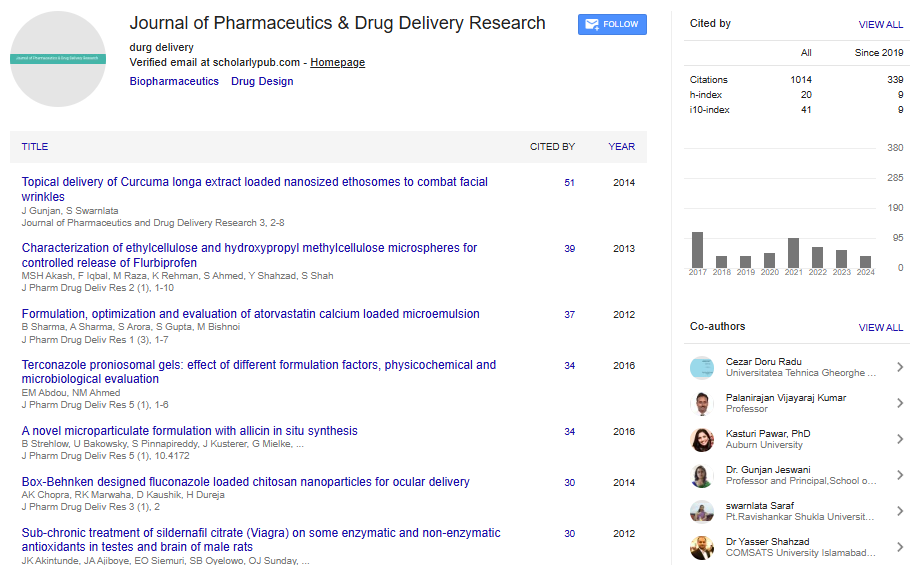Opinion Article, J Pharm Drug Deliv Res Vol: 13 Issue: 6
Biopharmaceutics: Establishing Drug Properties with Therapeutic Outcomes
Niklas Nilsson*
1Department of Pharmaceutics, Lund University, Lund, Sweden
*Corresponding Author: Niklas Nilsson,
Department of Pharmaceutics, Lund University, Lund, Sweden
E-mail: nilss.nikl@gmail.com
Received date: 28 October, 2024, Manuscript No. JPDDR-24-154094;
Editor assigned date: 30 October, 2024, PreQC No. JPDDR-24-154094 (PQ);
Reviewed date: 13 November, 2024, QC No. JPDDR-24-154094;
Revised date: 20 November, 2024, Manuscript No. JPDDR-24-154094 (R);
Published date: 29 November, 2024, DOI: 10.4172/2325-9604.1000308
Citation: Nilsson N (2024) Biopharmaceutics: Establishing Drug Properties with Therapeutic Outcomes. J Pharm Drug Deliv Res 13:6.
Description
Biopharmaceutics is an essential structure within pharmaceutical sciences, focusing on the interplay between a drug's physicochemical properties, its dosage form and the biological processes it occurs after treatment. This field integrates pharmacology, medicine and formulation science, resulting in the optimization of therapeutic efficacy and pharmaceutical safety. Biopharmaceutics examines how the physical and chemical properties of a drug, the formulation and the way of administration affect the drug's bioavailability, absorption, distribution, metabolism and excretion. It is significant in designing effective drug delivery systems that achieve the desired therapeutic outcomes with minimal side effects.
Techniques in Biopharmaceutics
Biopharmaceutics employs a wide range of experimental and analytical techniques to study drug absorption, distribution and action:
Dissolution testing: Simulates drug release from dosage forms under controlled conditions.
Permeability testing: Assesses a drug’s ability to cross biological membranes using cell culture models.
Bioavailability studies: Measure the range and frequency of drug absorption in humans or animal models.
Pharmacokinetic analysis: Uses plasma drug concentrations to evaluate absorption, distribution and elimination.
Predictive simulations: Computational models predict drug absorption, distribution and interactions based on physicochemical properties.
Physiologically Based Pharmacokinetic (PBPK) models: Physiologically based pharmacokinetic models integrate biological and chemical data to simulate drug behavior.
Challenges in biopharmaceutics
Despite its significance, biopharmaceutics examines multiple challenges that require different methods. Many discovered drugs exhibit low solubility or poor membrane permeability, limiting their bioavailability. Techniques such as particle size reduction, salt formation and nanotechnology-based delivery systems are employed to address these issues. Individual differences in physiology, genetics and disease states lead to variability in drug absorption and response. Personalized medicine and pharmacogenomics aim to address these variations. Drugs that are variable in the acidic environment of the stomach or susceptible to enzymes degradation require protective formulations including enteric coatings. Ensuring that novel formulations accomplish severe regulatory standards for bioavailability and bioequivalence may cause in difficulties in product development.
Important factors in biopharmaceutics
Several factors influence the behavior of drugs in the body for their biopharmaceutical properties.
Physicochemical properties of the drug: A drug is required to dissolve in the body's tissues before it can be absorbed. Poorly soluble drugs face significant absorption challenges. The balance between lipophilicity and hydrophilicity affects membrane permeability and absorption. Smaller molecules generally diffuse more easily across biological membranes. A drug's ionization, influenced by pH, impacts its solubility and absorption.
Dosage form characteristics: Dosage forms influence the rate and extent of drug release. Additives can enhance or inhibit drug solubility, stability and absorption. Amorphous forms frequently dissolve faster than crystalline forms, enhancing absorption.
Physiological factors: The speed at which a drug moves through the Gastrointestinal (GI) tract affects its absorption. The varying pH levels in the stomach and intestines influence drug solubility and stability. Enzymes in the GI tract may degrade some drugs before absorption. Increased blood flow in absorption sites can enhance drug uptake. Extensive liver metabolism can reduce the amount of drug reaching systemic circulation.
Applications of biopharmaceutics
Biopharmaceutics is integral to various aspects of pharmaceutical science and healthcare.
Drug development: Biopharmaceutics affects formulation design ensuring drugs achieve optimal bioavailability and therapeutic effects. It is also essential in developing generic drugs that accomplish the bioequivalence requirements.
Personalized medicine: Understanding individual variability in drug absorption and metabolism allows for personalized therapies that maximize efficacy and minimize adverse effects.
Regulatory compliance: Regulatory organizations require biopharmaceutical information for evaluating the safety and effectiveness of novel medications and formulations. Bioequivalence studies are a foundation of generic drug approval.
Solving global health challenges: Biopharmaceutics contributes to the development of heat-stable formulations, improved vaccine delivery systems and treatments are easily accessible to groups with limited access.
 Spanish
Spanish  Chinese
Chinese  Russian
Russian  German
German  French
French  Japanese
Japanese  Portuguese
Portuguese  Hindi
Hindi 
